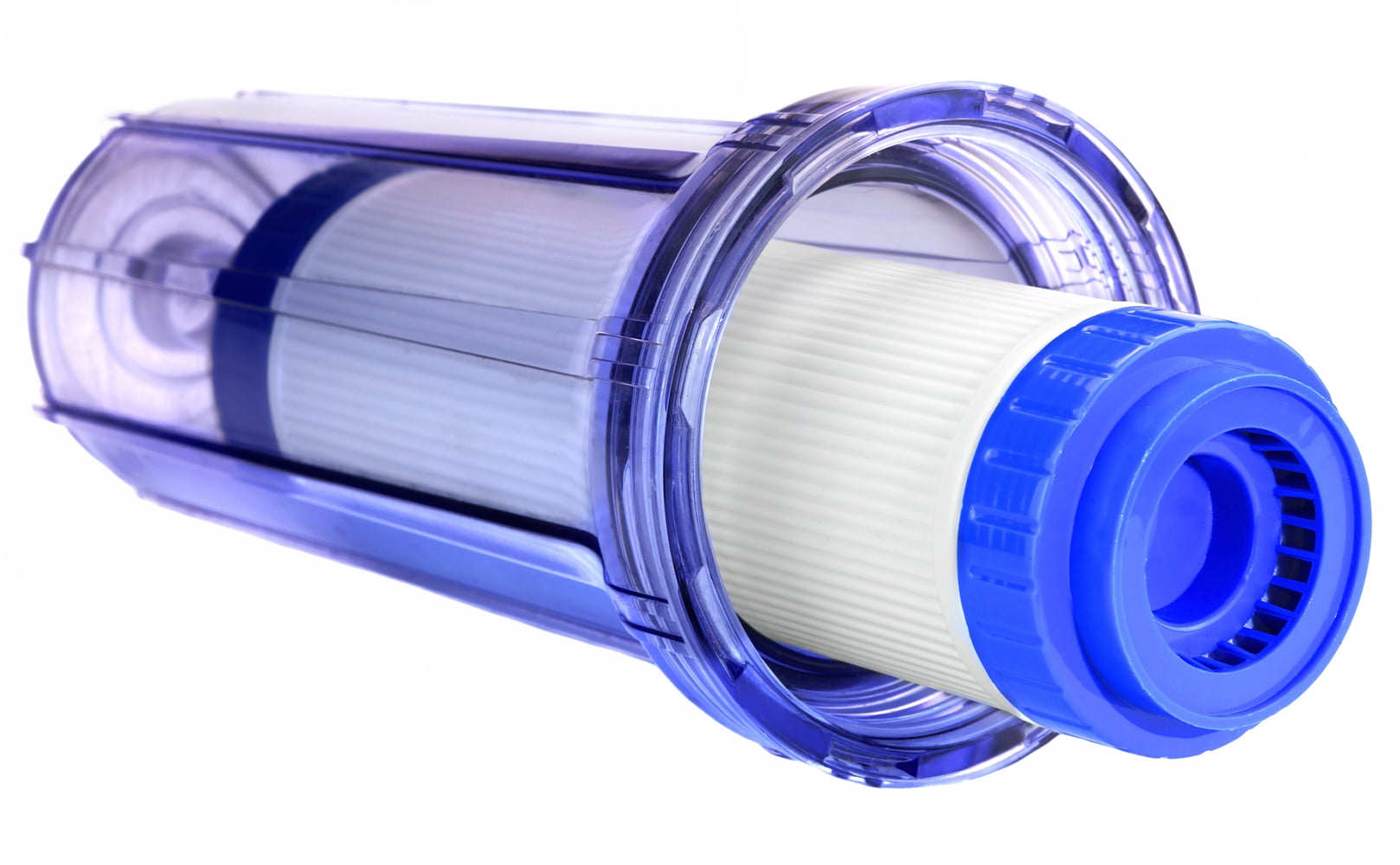How to Change a Whole House Water Filter Step by Step
Written by: Gene Fitzgerald // Last Updated: Aug 25, 2023
This page may contain affiliate links. If you buy a product or service through such a link we earn a commission at no extra cost to you. Learn more.
Almost all whole house water filters require a little bit of maintenance every once in a while to perform at their best. Timely cartridge replacements usually do the trick.
But how do you do that actually and how often do you have to change filters? And what happens if you neglect your duties? Don’t worry, we’ve got you covered.
Key Takeaways
These are the steps on how to change a whole house water filter:
- Turn off the water supply.
- Depressurize the filter system.
- Unscrew and remove the filter housing.
- Remove the old filter cartridge.
- Tip: You can clean the filter housing with a brush and soapy water or household bleach. Rinse afterward.
- Lubricate the housing’s O-rings and make sure they are seated correctly. If any is not in good shape, replace it.
- Re-install the filter housing with a new cartridge inside.
- Slowly turn on the water supply and nearby faucets.
- Check for leaks.
Whole House Water Filter Replacement
Replacing a whole house water filter is matter of minutes as long as you have all the necessary tools and accessories at hand and know what you are doing. You don’t? Well, then this will help you out:
Tools & Accessories Needed
- Replacement cartridge
- Housing wrench
- Bucket
- Bucket with soapy water (optional)
- Household bleach (optional)
Step-by-Step Instructions
- Step one is always to turn off the water supply. To do that, close the valve at the main water line or the inlet valve right before your filter in case you have installed an extra one. It’s also possible that the unit features a built-in valve that you can close.
- Open the nearest faucets or other outlets to drain as many of the remaining water as possible. Most of the water will be out of your plumbing system once you see a significant drop in flow rate and pressure.
- If you also have an outlet valve, now is the time to close it. This will stop water from draining back from your house.
- Press and hold the pressure relief button on each filter housing for a couple of seconds just to make sure that you are not dealing with overpressure.
- Unscrew the (first) housing with the help of the wrench. Have an empty bucket at the ready to collect spilling water.
- Remove the old cartridge from inside the housing. Throw it in the empty bucket for now and remember to dispose it appropriately when you are done.
- Optional: The housings are a typical component where dirt and bacteria are likely to accumulate. Thus it is always a good idea to clean their inside with soapy water or household bleach and a brush. Thoroughly rinse with plain water afterwards.
- Lubricate the housing’s O-ring with food-grade silicone grease and make sure that it is seated level in place. If the O-ring is not in good shape anymore, replace it.
- Place a new cartridge inside the housing and screw it back on. It should be enough to tighten by hand – a properly seated O-ring will prevent any leakages.
- Now you can slowly turn the water supply back on. Open all valves upstream of the system.
- Check for leaks. Pay special attention to all housings that you just removed.
- In case of leaks, quickly turn off the water supply and carefully tighten any connections to stop the dripping.
- Now you can open the water supply for good as well as all valves leading away from the unit.
- Open several faucets to flush the new cartridge for a couple of minutes (see manufacturer instructions). This will also help to purge any air from your plumbing.
- Once water pressure and flow rate are back to normal close all faucets and you are done!
Video
Too lazy; didn’t read? Check out this video:
What If I’m on a Well?
This doesn’t really matter. Changing a well water filter works exactly the same like replacing one on a city supply.
Help, My Filter Housing Is Stuck!
If your filter housing is stuck and you’ve already opened one or more faucets to release some of the pressure inside of it and you’ve also used the pressure release button at the top, do not despair just yet!
There are a couple of things that might help:
- Sometimes it is enough to tap on the filter head outside the thread.
- Use a hair dryer and blow hot air on the top.
- Use the wrench and push it as far up the housing as possible. With your free hand support the filter bracket. Try to turn the wrench in clockwise direction (looking down on the filter). If that doesn’t help use some additional leverage like a tube. If you have a plastic wrench and it starts to bend you might require a metal one. Another cool trick is to use 2 plastic wrenches simultaneously.
Didn’t do the trick? Then it’s probably best to remove the entire unit from the water line and carefully grip it in a vice. Now you can open the housing with brute force. If you are sick of your old filter, check out our whole house water filter reviews to find a new one.
How can you prevent this from happening again? First of all, make sure that the O-ring is intact and free from dirt. If you find any cracks or other defects replace the O-ring. Then lubricate it with food-grade silicone grease as we’ve mentioned above. Also, make sure that its seat and the contact surface inside the head is clean.
How Often to Change a Whole House Water Filter
How often you need to change the filter(s) of your whole house system depends on a couple of factors:
- Their type, size and capacity (rated in gallons and/or months)
- Feed water quality (more impurities will decrease filter lifespan and therefore increase replacement frequency)
- Well vs. city water
- Sediment and iron content
- Water hardness
- Other impurities
- How much water you use on a daily basis
As a general rule, most filters will last anywhere between 1 and 6 months. Sediment pre-filters require the most frequent changes, whereas carbon filters have a higher life expectancy. Post-filters can last up to 9-12 months.
Helpful indicators are discoloration and unpleasant taste/odor as well as a drop in water pressure and flow rate which are hints that your filter has exceeded its capacity and is clogged.
You can also learn from the old cartridge. What condition is it in at the time of replacement? If it still looks brand-new, maybe use it for a bit longer. If it’s super dirty and worn out, change earlier next time.
We also advise you to consult your manual or contact the manufacturer directly. The customer support will give you a more specific time frame.
What Happens If You Don’t Replace Your Filter?
What happens if you don’t change your filter according to plan? It will lose its filtering efficiency. For instance:
An old sediment filter that is supposed to trap particles such as rust will allow some of the contaminants to pass through, which will then end up in your drinking glass and also compromise the performance of your other home appliances. Worst case scenario: The lifespan of your water heater, washing machine, dishwasher, etc. will be shortened.
What’s more, most water experts recommend to replace cartridges at least once a year to prevent germs like bacteria and mold from growing inside of it. This is something you have to avoid at all costs to protect your health.
If you have any questions about how to change a whole house water filter, please don’t hesitate to leave a comment below!
Information provided on BOS is for educational purposes only. The products and services we review may not be right for your individual circumstances.
We adhere to strict editorial guidelines. Rest assured, the opinions expressed have not been provided, reviewed, or otherwise endorsed by our partners – they are unbiased, independent, and the author’s alone. Our licensed experts fact-check all content for accuracy. It is accurate as of the date posted and to the best of our knowledge.


